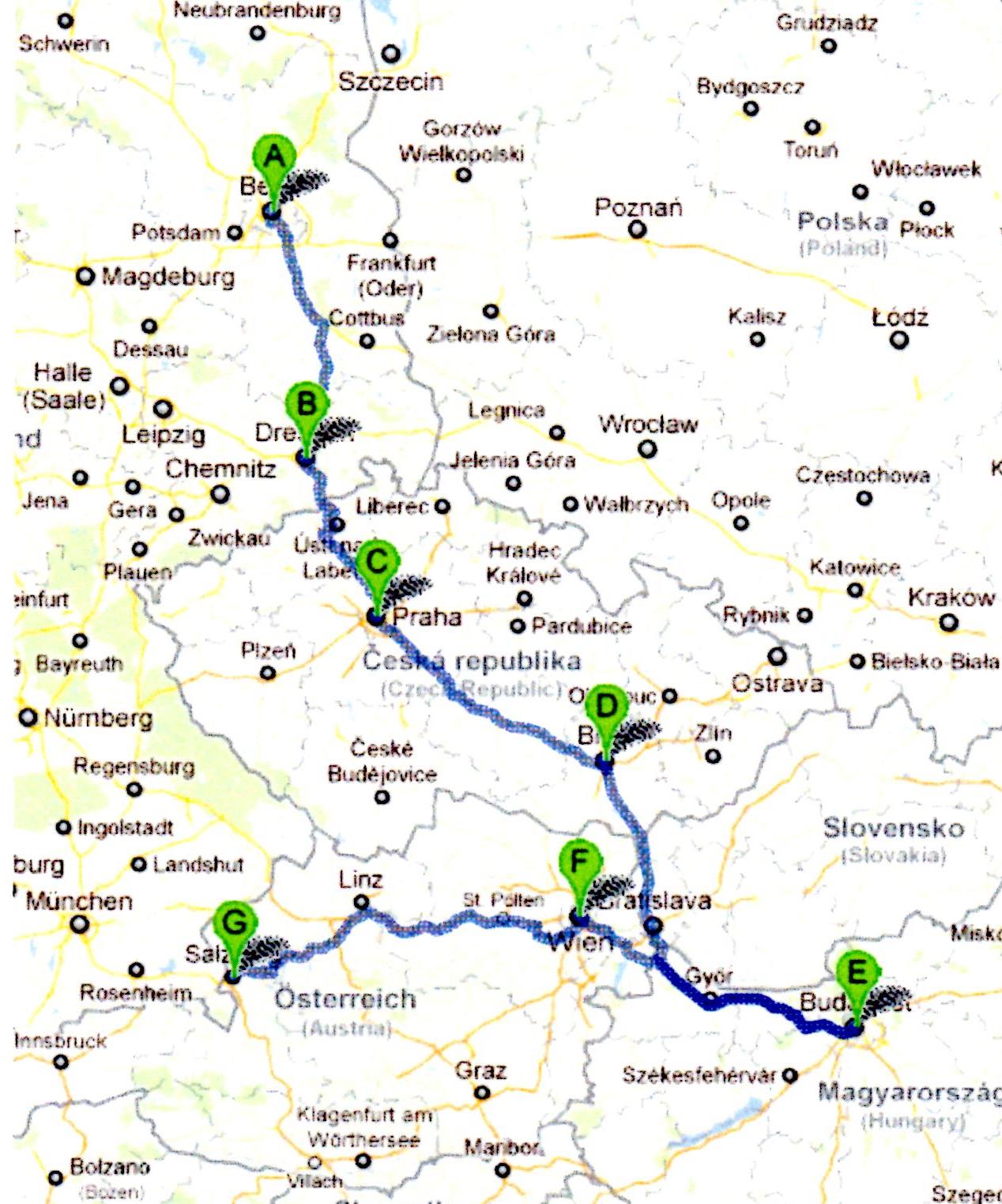CENTRAL EUROPE 2011
Day
4
September 5 Monday -
BERLIN
We
didn't set our alarm last night so we didn't wake up until 9:45. It was
raining so after we had breakfast in our apartment, we took a taxi to the Jewish
Museum. It appeared to be a long walk from our apartment, and not too
close to a metro stop.
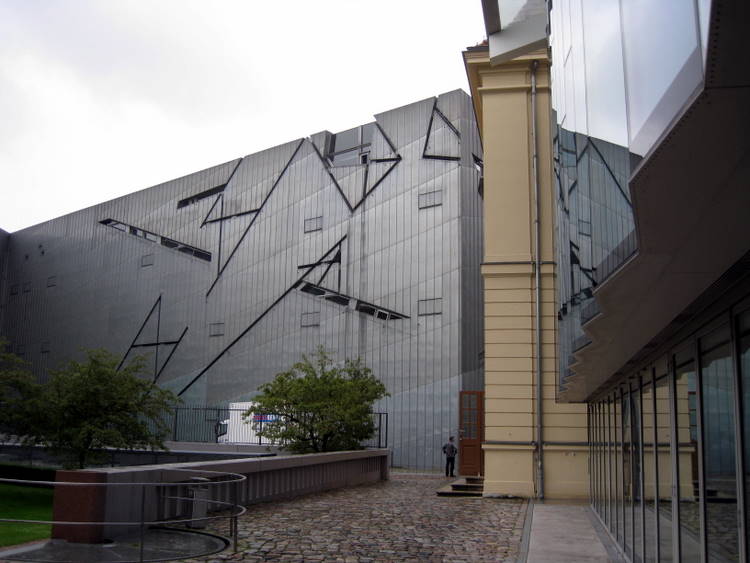
The
Jewish Museum designed by American Architect Daniel Libeskind, who is
redeveloping New York’s World Trade Center site, opened its doors in 2001. The
very modern building with zinc-paneling creates a connection between the
museum’s themes and its architecture.
Libeskind has dubbed his design “Between the Lines,” a title which
reflects the tensions of German-Jewish history. “ Inscribed within the design
of the building, this past takes shape along two lines charting various cultural
connections and modes of thought: one is straight, but broken into many
fragments; the other is winding and open-ended.
The building’s zigzag shape is pierced by voids symbolic of the
irreplaceable cultural loss caused by the Holocaust.” (Museum
booklet).
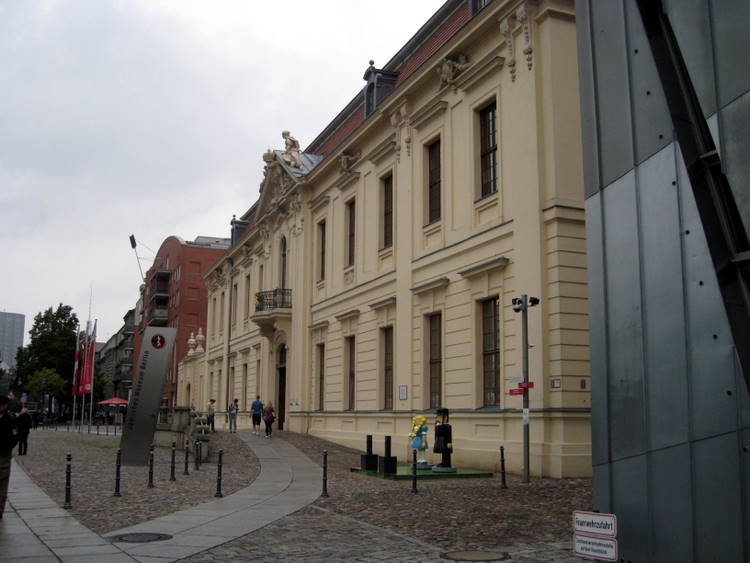
The
building is entered through an 18th century Baroque building next
door. We first visited two of the
three memorial spaces. First was the
Axis of Holocaust, which was a large empty, very tall tower with a small window
at the top. Only a few people at a
time were admitted and the door shut. There
wer e many people just sitting in silence on the floor.
It served as an uncomfortable reminder of the sensation of being held
prisoner in such a tower.
e many people just sitting in silence on the floor.
It served as an uncomfortable reminder of the sensation of being held
prisoner in such a tower.
The
next stop was the Axis of Exile. It
was very similar to but smaller than the outdoor Memorial to the Murdered
Jewish. The area consisted of 49
pillars set on an uneven walkway. Walking
through this garden gave a sense of being disorientated and feeling dizzy.

The
third area, which was not opened today, was the Memory Void.
It is a thought provoking space of “fallen leaves”: heavy metal faces
that you walk on. We looked
down on this area from another part of the museum.
The tour of the museum itself begins on the top floor.
There are elevators for those of us who find it difficult to climb steps.
On the top floor begins a 2,000 year story of Judaism in Germany.
Some of the exhibits are interactive.
There are English explanations of the exhibits and the symbolism of the
building.
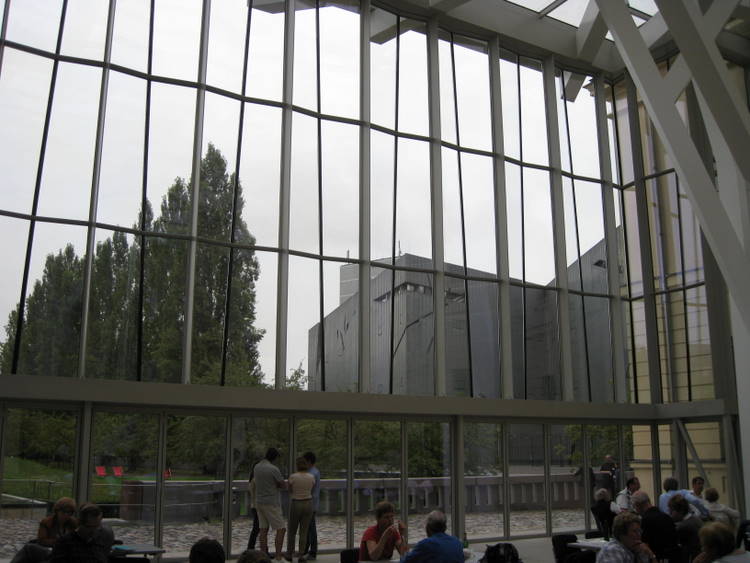
We
spent three hours with these moving exhibits. On the back side of the baroque
building was a large glassed-in eating area with an adjacent buffet. We
ate lunch there. PLEASE
SEE MY MODEL.
We
walked several blocks until we came to a metro stop.
We weren’t real sure which train to take, but a nice man helped us. We
took the metro to Kaiser Wilhem church which is in the Charlottenburg section
where we were yesterday. There was
only a slight drizzly by this time.
The
foundation stone of the original church was laid in 1891 as a memorial to the
first Emperor of Germany. Reliefs
and mosaics show the great events in the life of Kaiser Wilhelm, from his
coronation in 1871 to his death in 1888.
This church was destroyed during a night of air-raid on November 23,
1943. All that remained when the war
was finished were ruins, but the difficult conditions of the post-war years
prevented reconstruction, although there was a lobby for restoring the church to
its familiar form. It was not until
1956 that a competition was started to design and build a new church.
The new church was designed by architect Egon Eiermann and
consecrated on December 17, 1961. It
consists of four separate buildings grouped around the ruins of the old church
tower.
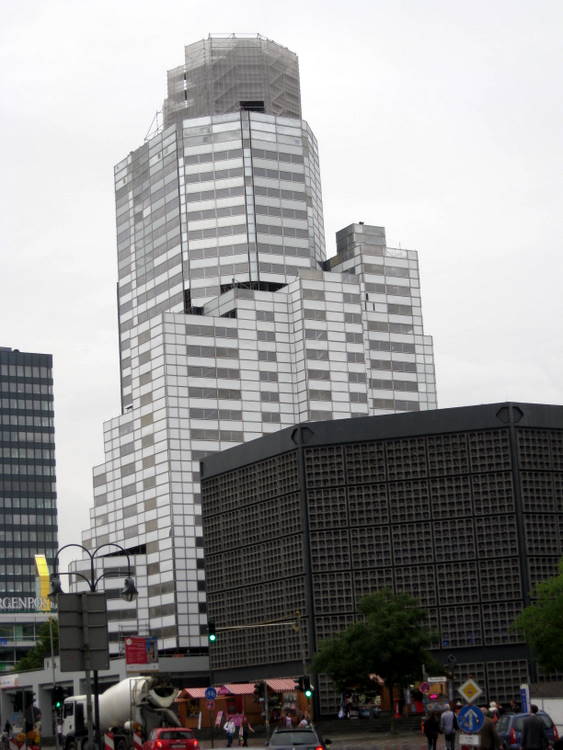
SEE
MY MODEL. When we visited the ruined old church tower was
being worked on and was covered with the "fake" building canvass.
The very tip of the tower can be seen above the canvass. The canvass was
removed in 2012.
The
plan of the church is octagonal while the plan of the tower is hexagonal. The
new buildings are constructed of concrete, steel and glass. The walls of the
church are made of a concrete honeycomb containing 21,292 stained glass inlays.
The glass, designed by Gabriel Loire was inspired by the colors of the glass in
Chartres Cathedral in France. The
predominant color is blue, with small areas of ruby red, emerald green and
yellow.
The
entrance hall in th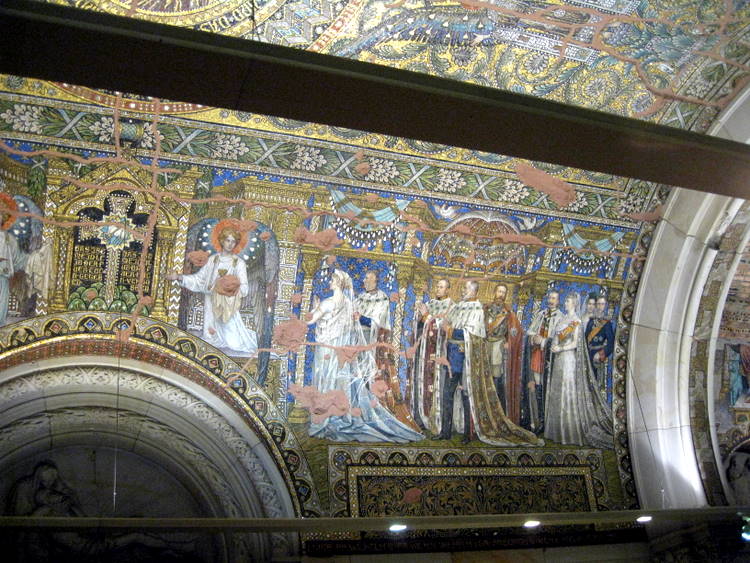 e base of the damaged spire is open to visitors. Its
floor contains a mosaic of the Archangel Michael fighting the dragon. The
vault shows a procession of Hohenzollern princes. Other mosaics show important
monarchs in medieval Germany, Reformation thinkers and Reformation princes. Bas-relief
sculptures illustrate scenes from biblical stories, scenes from the life of
Kaiser Wilhelm I and symbolic figures representing war and peace. In the north
apse are 16 display panels which tell the story of the old church and its
destruction. At the opposite end of the hall are three items which symbolize the
history of the church. In the middle is a damaged statue of Christ which
originally stood on the altar of the old church. To its right is the Cross of
Nails which was made from nails in the roof timbers of Coventry Cathedral in
England. This cathedral had been severely damaged in a German air raid on
November 14, 1940. To the left of the statue of Christ is an icon cross
which was given by the Russian Orthodox Church and handed over in 1988.
e base of the damaged spire is open to visitors. Its
floor contains a mosaic of the Archangel Michael fighting the dragon. The
vault shows a procession of Hohenzollern princes. Other mosaics show important
monarchs in medieval Germany, Reformation thinkers and Reformation princes. Bas-relief
sculptures illustrate scenes from biblical stories, scenes from the life of
Kaiser Wilhelm I and symbolic figures representing war and peace. In the north
apse are 16 display panels which tell the story of the old church and its
destruction. At the opposite end of the hall are three items which symbolize the
history of the church. In the middle is a damaged statue of Christ which
originally stood on the altar of the old church. To its right is the Cross of
Nails which was made from nails in the roof timbers of Coventry Cathedral in
England. This cathedral had been severely damaged in a German air raid on
November 14, 1940. To the left of the statue of Christ is an icon cross
which was given by the Russian Orthodox Church and handed over in 1988.

We
spent some time in the church itself which was quite beautiful with all of the
blue glass. At the present time the
old church is under some reconstruction through 2012. We were disappointed that
we could not see it, as it was wrapped in an aluminum tent to prevent dust and
allow work during inclement weather.
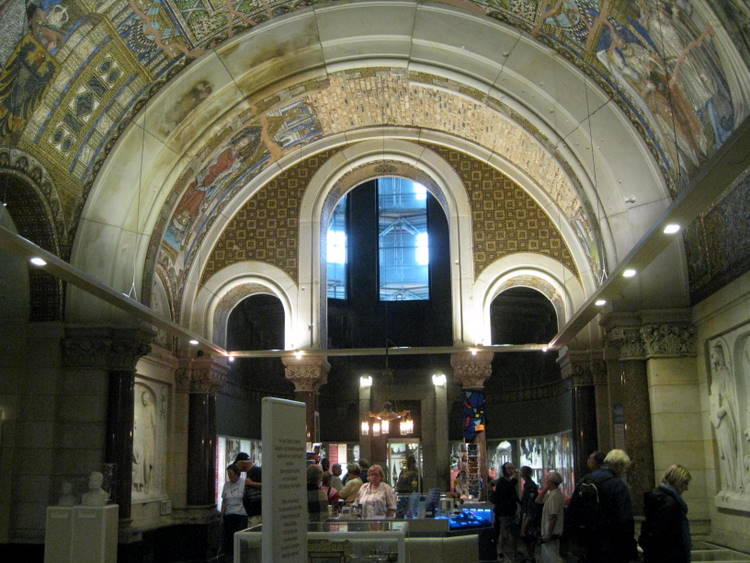
We
spent a long time in the entrance hall, admiring the mosaics, the pictures and
the gifts at the right end of the hall.
We
caught the metro (it is call the S bahn for the above ground and U bahn for
underground). We are getting pretty
good finding our way around by the metro. Our
station, Hackescher Market, is just a block from our hotel.
We got back to our station a little after 5:00 pm.
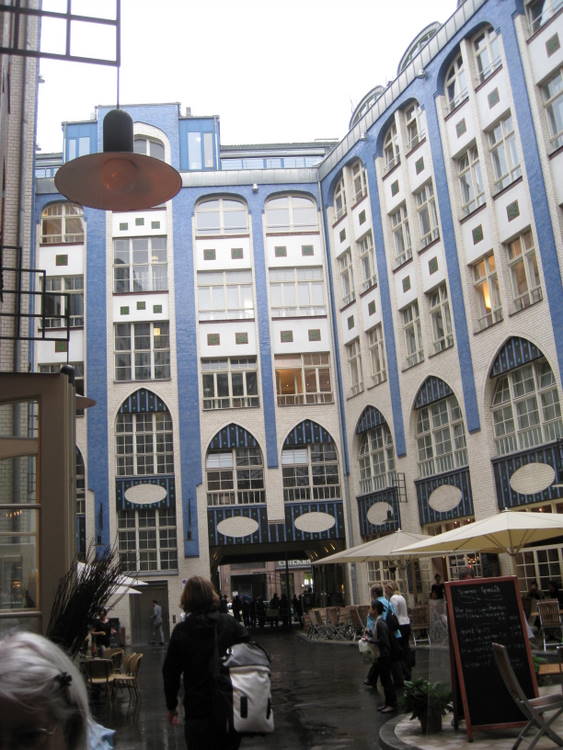
Although
out lunch was filling, we thought we had better find somewhere to eat.
At the ground level of the Hackescher Market tram station are a number of
outdoor cafes. We notice others down
the street so we started exploring. We
found a beautiful restaurant -The Oxymoron- situated
in the first Art Nouveau courtyard of the “Hackesche Höfe” a block away
from the Hackescher Market Station.
It
was a new, rather modern restaurant. We began by having drinks at a small table
near the outdoor dining area. We
finally decided that we were hungry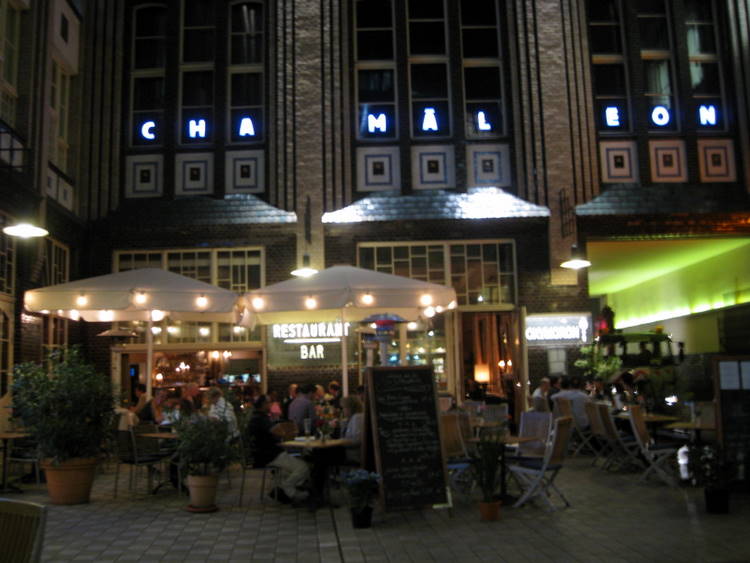 and it looked like a wonderful place to have
dinner. We were able to move
to a larger table in the middle of the dining room. I had an Argentinan Steak
with sweet potatoes and parsnips. My
wife had risotto with pig. It was
wonderful meal. We are so pleased to have stumbled on this great place.
We would highly recommend it.
and it looked like a wonderful place to have
dinner. We were able to move
to a larger table in the middle of the dining room. I had an Argentinan Steak
with sweet potatoes and parsnips. My
wife had risotto with pig. It was
wonderful meal. We are so pleased to have stumbled on this great place.
We would highly recommend it.
We came back to the apartment, and used our washer/dryer for the first
time. The washer is “new-fangled”, and it sounds like it's ready to take
off. It was nice to have a washer
and dryer in our apartment.




 e many people just sitting in silence on the floor.
It served as an uncomfortable reminder of the sensation of being held
prisoner in such a tower.
e many people just sitting in silence on the floor.
It served as an uncomfortable reminder of the sensation of being held
prisoner in such a tower.

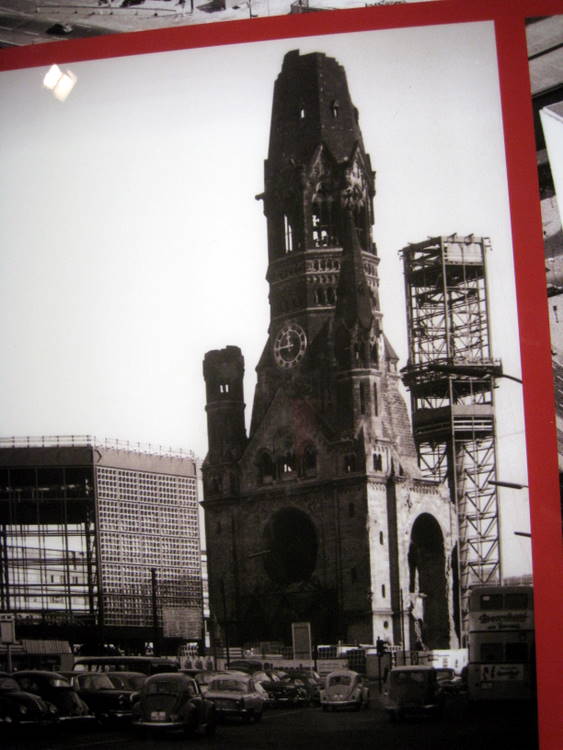


 e base of the damaged spire is open to visitors. Its
floor contains a mosaic of the Archangel Michael fighting the dragon. The
vault shows a procession of Hohenzollern princes. Other mosaics show important
monarchs in medieval Germany, Reformation thinkers and Reformation princes. Bas-relief
sculptures illustrate scenes from biblical stories, scenes from the life of
Kaiser Wilhelm I and symbolic figures representing war and peace. In the north
apse are 16 display panels which tell the story of the old church and its
destruction. At the opposite end of the hall are three items which symbolize the
history of the church. In the middle is a damaged statue of Christ which
originally stood on the altar of the old church. To its right is the Cross of
Nails which was made from nails in the roof timbers of Coventry Cathedral in
England. This cathedral had been severely damaged in a German air raid on
November 14, 1940. To the left of the statue of Christ is an icon cross
which was given by the Russian Orthodox Church and handed over in 1988.
e base of the damaged spire is open to visitors. Its
floor contains a mosaic of the Archangel Michael fighting the dragon. The
vault shows a procession of Hohenzollern princes. Other mosaics show important
monarchs in medieval Germany, Reformation thinkers and Reformation princes. Bas-relief
sculptures illustrate scenes from biblical stories, scenes from the life of
Kaiser Wilhelm I and symbolic figures representing war and peace. In the north
apse are 16 display panels which tell the story of the old church and its
destruction. At the opposite end of the hall are three items which symbolize the
history of the church. In the middle is a damaged statue of Christ which
originally stood on the altar of the old church. To its right is the Cross of
Nails which was made from nails in the roof timbers of Coventry Cathedral in
England. This cathedral had been severely damaged in a German air raid on
November 14, 1940. To the left of the statue of Christ is an icon cross
which was given by the Russian Orthodox Church and handed over in 1988.






